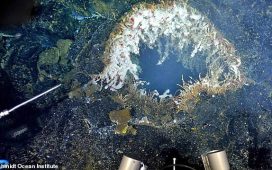October 17, 2023

Cyclotron Radiation Emission Spectroscopy (CRES), seen here, is the key to a totally new method that aims to pin down the mass of the elusive neutrino.Project 8
The humble neutrino, an elusive subatomic particle that passes effortlessly through normal matter, plays an outsized role among the particles that comprise our universe. To fully explain how our universe came to be, scientists need to know its mass.
But, as it turns out, the neutrino avoids being weighed.
In a paper published Sept. 6 in Physical Review Letters, an international team of researchers in the United States, Germany and France reported that a distinctive strategy they have used shows real promise to be the first approach to measure the mass of the neutrino. Once fully scaled up, their collaboration — Project 8 — could also reveal how neutrinos influenced the early evolution of the universe as we know it.
“Project 8 is an entirely new approach to trying to solve this outstanding, fundamental problem in physics — the mass of the neutrino — and we really think it is on course to answer this question and so much more,” said co-author and Project 8 scientist Elise Novitski, a University of Washington assistant professor of physics.
In 2022, KATRIN, a separate collaboration based in Germany, set a new upper limit for the neutrino’s mass — a decades-long endeavor that UW researchers helped lead. But KATRIN is eventually expected to reach the limits of how much it can narrow the range of the neutrino’s mass, leaving scientists around the world asking, “What’s next?”
Project 8 scientists believe their approach might be the answer. Their work focuses on a well-characterized phenomenon called beta decay. Many radioactive variants of elements undergo this process. Project 8 hinges on using the beta decay of tritium — a rare, radioactive variant of hydrogen — to calculate the mass of the neutrino.
When tritium undergoes beta decay, it generates a helium ion, an electron and a neutrino. Rather than try to detect the neutrino, which passes through most detector technology, the research team has instead focused on measuring the free electron generated during beta decay. These electrons carry away most — but not all — of the energy released by beta decay. And that “missing” energy is made up of the neutrino’s mass and motion.
“The neutrino is incredibly light,” said co-author Talia Weiss, a Project 8 scientist and graduate student at Yale University. “It’s more than 500,000 times lighter than an electron. So, when neutrinos and electrons are created at the same time, the neutrino mass has only a tiny effect on the electron’s motion. We want to see that small effect. So, we need a super-precise method to measure how fast the electrons are zipping around.”
In their recent paper, Project 8 scientists showed that they can use a new technique — cyclotron radiation emission spectroscopy, or CRES — to reliably track and record beta decay. According to their results, CRES could be used to calculate neutrino properties, including its mass.
“In principle, with technology developments and scale up, we have a realistic shot at getting into the range necessary to pin down the neutrino mass,” said co-author Brent VanDevender, a Project 8 scientist at the Pacific Northwest National Laboratory, a U.S. Department of Energy facility.
Physicists Joe Formaggio and Ben Monreal first conceived of CRES more than a decade ago at the Massachusetts Institute of Technology. An international team rallied around the idea and formed Project 8 to convert their vision into a practical tool. CRES captures the microwave radiation emitted from newborn electrons as they spiral around in a magnetic field.
Project 8 scientists spent years figuring out how to accurately tease out the electron signals from background noise. Weiss and Christine Claessens — a UW postdoctoral researcher who worked on Project 8 as a doctoral student at the University of Mainz in Germany — performed the two final analyses that placed limits on the neutrino mass using CRES data. This is the first time that tritium beta decays have been measured, and an upper limit placed on the neutrino mass, with the CRES technique.
The CRES detector, built and housed at the UW, measures that crucial electron energy with the potential to scale up beyond any existing technology. Novitski said that scalability is what sets Project 8 apart.
“Nobody else is doing this,” Novitski said. “We’re not taking an existing technique and trying to tweak it a little bit. We’re kind of in the Wild West.”
In their most recent experiment, the team tracked 3,770 tritium beta decay events over an 82-day trial window in a sample cell the size of a pea. The sample cell is cryogenically cooled and placed in a magnetic field that traps the emerging electrons long enough for the system’s recording antennas to register a microwave signal.
A subset of Project 8 researchers have also developed a suite of specialized software — each named after insects, like Katydid and Dragonfly — to convert raw data into signals that can be analyzed. And project engineers have had to design and build the hardware and detectors that make Project 8 come together.
“We do have engineers who are crucial to the effort,” Novitski said. “It’s kind of out there from an engineer’s point of view. Experimental physics is at the boundary of physics and engineering. You have to get particularly adventurous engineers and practical-minded physicists to collaborate, to make these things come into being, because this stuff is not in the textbooks.”
Now that the team has shown their experimental system works using molecules of tritium, they’re working on designs for scaling up the experiment from the pea-size sample chamber to one a thousand times larger to capture more beta decay events. They’re also developing an experimental set-up to produce, cool and trap individual atoms of tritium — no easy feat since tritium, like its more abundant cousin hydrogen, prefers to bind to other atoms and form molecules.
Meeting these goals, and scaling up the whole apparatus, will be the critical steps to reaching and ultimately exceeding the sensitivity achieved by the KATRIN experiment.
“This will be a years-long effort. But one that we think will finally give us this small answer — the mass of this tiny neutrino — with huge implications,” said co-author and Project 8 scientist Gray Rybka, a UW professor of physics.
Other UW co-authors include current and former graduate students Ali Ashtari Esfahani, Jeremy Hartse and Eris Machado; Peter Doe, emeritus research professor of physics; and Hamish Robertson, professor emeritus of physics. Project 8 is funded by the U.S. Department of Energy, the National Science Foundation, the German Research Foundation and internal investments by collaborating institutions.
For more information, contact Novitski at en37@uw.edu.
Adapted from a story by the Pacific Northwest National Laboratory.
Tag(s): College of Arts & Sciences • Department of Physics • Elise Novitski • Gray Rybka • physics











